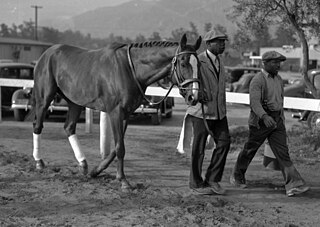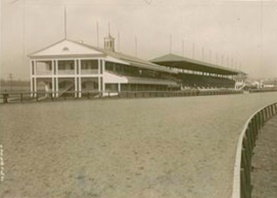
The Preakness Stakes is an American thoroughbred horse race held annually on Armed Forces Day, the third Saturday in May at Pimlico Race Course in Baltimore, Maryland. The Preakness Stakes is a Grade I race run over a distance of 1+3⁄16 miles on dirt. Colts and geldings carry 126 pounds (57 kg); fillies 121 pounds (55 kg). It is the second jewel of the Triple Crown, held two weeks after the Kentucky Derby and three weeks before the Belmont Stakes.

Alfred Gwynne Vanderbilt Jr. was a British-born member of the prominent Vanderbilt railroad family, and a noted figure of American thoroughbred horse racing. He was the youngest-ever member of The Jockey Club, president of Belmont Racetrack, New York, and Pimlico Race Course, Baltimore, and chairman of the board of the New York Racing Association. In World War II, he was decorated for bravery in the South Pacific.

Native Dancer, nicknamed the Gray Ghost, was one of the most celebrated and accomplished Thoroughbred racehorses in American history and was the first horse made famous through the medium of television. He was a champion in each of his three years of racing, and was inducted into the National Museum of Racing and Hall of Fame in 1963. In the Blood-Horse magazine List of the Top 100 U.S. Racehorses of the 20th Century, he was ranked seventh.

Pimlico Race Course is a thoroughbred horse racetrack in Baltimore, Maryland, most famous for hosting the Preakness Stakes. Its name is derived from the 1660s when English settlers named the area where the facility currently stands in honor of Olde Ben Pimlico's Tavern in London. The racetrack is nicknamed "Old Hilltop" after a small rise in the infield that became a favorite gathering place for thoroughbred trainers and race enthusiasts.
Belair Stud was an American thoroughbred horse racing stable and breeding farm founded by Provincial Governor of Maryland Samuel Ogle in 1747 in Collington, Prince George's County, Maryland, in Colonial America.

Laurel Park, formerly Laurel Race Course, is an American thoroughbred racetrack located just outside Laurel, Maryland which opened in 1911. The track is 1+1⁄8 miles in circumference. Its name was changed to "Laurel Race Course" for several decades until returning to the "Laurel Park" designation in 1994.
Neil D. Drysdale is an American-based thoroughbred race horse trainer.
Kauai King was an American Thoroughbred racehorse was foaled on April 3, 1963, at Sagamore Farm in Glyndon, Maryland. His sire was Native Dancer and his dam was Sweep In. In 1966, Kauai King won the first two legs of the U.S. Triple Crown. To date, Kauai King is one of only two horses born in Maryland to have crossed the Kentucky Derby finish line first, but 1968 winner Dancer's Image was later stripped of his title, leaving Kauai King as the only official Maryland-bred winner of the Derby.

Discovery (1931–1958) was a champion American Thoroughbred racehorse. In a racing career which lasted from 1933 to 1936 he ran sixty-three times and won twenty-seven races. One of the leading American three-year-olds of his generation in 1934, he became a dominant performer in the next two seasons. The National Museum of Racing and Hall of Fame said that he was: "...considered one of the greatest horses of the 20th century."

Bahram (1932–1956) was an Irish-bred, English-trained Thoroughbred racehorse. He was undefeated in nine races in a career that lasted from July 1934 until September 1935. He was one of the most impressive horses and was named "Horse of the century" and The leading British two-year-old of 1934. He went on to take the Triple Crown in 1935 by winning the 2000 Guineas Stakes, Epsom Derby, and St. Leger Stakes. He was retired to stud at the end of the year. After a promising start to his stud career in Britain, he was exported to the United States, where he had moderate success before being exported again to Argentina.
Hansel was an American Thoroughbred racehorse who won the final two legs of the U.S. Triple Crown races in 1991 and was voted the Eclipse Award for Outstanding 3-Year-Old Male Horse. Out of the mare Count on Bonnie, his sire was Woodman, a Champion 2-year-old colt in Ireland who was a son of the influential Champion sire Mr. Prospector. Woodman also sired the 1994 Breeders' Cup Juvenile and Preakness Stakes winner, Timber Country, as well as the 1999 Canadian Champion 3-Year-Old Colt and Queen's Plate winner, Woodcarver. Hansel's owner was banker Joe Allbritton, who raced him under his Lazy Lane Farm banner.
Summer Squall was an American thoroughbred racehorse and sire, best known for his win in the 1990 Preakness Stakes, and his rivalry with Unbridled, whom he defeated in four of their six meetings. He later became a successful breeding stallion siring the Kentucky Derby winner Charismatic.
The Federico Tesio Stakes is an American Thoroughbred horse race held annually at Laurel Park in Laurel, Maryland over a distance of 1+1⁄8 miles on the dirt for three-year-old horses.

The Havre de Grace Racetrack was an American horse racing track on Post Road in Havre de Grace, Harford County, Maryland. Nicknamed "The Graw," it operated from August 24, 1912, to 1950. For a time, it was owned by the Harford Agricultural and Breeders Association and also by the notorious gambler Arnold Rothstein.
Bee Bee Bee was an American Thoroughbred racehorse best known for winning the 1972 Preakness Stakes. To date Bee Bee Bee is one of only eight Maryland-bred colts to win the Preakness, and one of only eleven from the state to win a triple crown race.
Eddington is a millionaire American Thoroughbred racehorse and successful sire bred in Kentucky by Carl Rosen and Associates and raced under the Willmott Stables banner. He finished racing with a record of 6-3-6 in 17 starts and career earnings of $1,216,760. Eddington was best known for his wins in the Grade I Pimlico Special and the Grade II Gulfstream Park Handicap as well as his in-the-money showing in the Grade I Preakness Stakes. As a yearling, he was sent to Ocala, Florida, to the master horsemen Art Fisher.
The Native Dancer Stakes is an American Thoroughbred horse race run annually at Laurel Park Racecourse in Laurel, Maryland. Raced in early January, it is open to horses age three and older and is contested on dirt over a distance of 1+1⁄8 mile. Its current purse is $75,000.
General Duke was an American Thoroughbred racehorse who won the second running of the Belmont Stakes in 1868. A son of Lexington, he was bred by Robert A. Alexander in Kentucky. He raced as a two-year-old, winning twice, including a stakes race. As a three-year-old, he raced nine times, winning six races, including several stakes. His final racing record was 18 wins from 32 starts. He was later known as Judge Curtis, and after his racing career ended he was a breeding stallion in Canada before dying in Illinois in 1888. Three of his daughters won stakes races.
Joseph Horace "Bud" Stotler was an American Thoroughbred horse racing Champion trainer who conditioned horses that won four Championships. He was of German descent.
Loser Weeper (1945–1960) was an American Thoroughbred racehorse bred and raced by Alfred Vanderbilt Jr. and trained by future U.S. Racing Hall of Fame inductee, Bill Winfrey. At the time of his retirement from racing in 1951, a major media publication for horse racing referred to Loser Weeper as "one of Discovery's outstanding sons."









